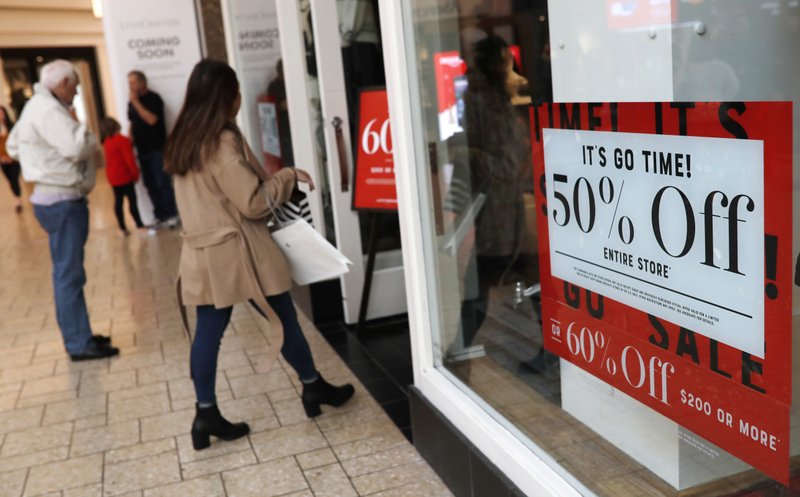This year's Christmas shopping season should see retail sales exceeding last year's, according to a trade group's annual forecast.
The National Retail Federation said Thursday that it expects Christmas sales to grow between 3.8% and 4.2% compared with 2018, to between $727.9 billion and $730.7 billion. The forecast covers November and December, and excludes sales at car dealerships, gas stations and restaurants.
Online and other nonstore sales, which are included in the federation's total, are forecast to rise between 11% and 14% to between $162.6 billion and $166.9 billion. Those sales totaled $146.5 billion last year, the federation said.
Matthew Shay, the National Retail Federation's president and chief executive officer, said that though the U.S. economy continues to grow, driven largely by consumer spending, "there has clearly been a slowdown brought on by considerable uncertainty around issues including trade, interest rates, global risk factors and political rhetoric." Continued deterioration of these and other factors could erode consumer confidence, he said.
Still, Shay said consumers "are in good financial shape," and retailers expect strong sales during the Christmas shopping season.
Some market research firms are a bit more optimistic than the National Retail Federation. Deloitte said last month that it expects to see Christmas sales grow between 4.5% and 5% this year, with e-commerce sales up 14% to 18% year over year. Similarly, AlixPartners forecasts a sales increase between 4.4% and 5.3% over last Christmas.
Walmart Inc. doesn't break out its Christmas sales figures, but last year's fourth quarter, which encompasses the shopping season, was its strongest in a decade. The Bentonville retailer's U.S. e-commerce sales surged 43% over the previous year's, and its U.S. division, which includes e-commerce, reported net sales of $90.5 billion, up 4.6% over the same quarter in 2017.
Overall, retailers reported Christmas season sales in 2018 of $701.2 billion, up 2.1% from the previous year, according to the National Retail Federation. The group had projected growth of 4.3% to 4.8%.
Sucharita Kodali, principal analyst at Forrester Research, said the retail federation is generally accurate in its forecasts. The only factor that might dampen sales this year would be tariffs, she said, but she doesn't think it likely that will happen.
"Walmart seems to be doing well in general, and there's no reason to think the momentum will slow down," Kodali said. "They seem to be taking share from many of the mall merchants and big-box stores that have been struggling recently, and they have been holding their own versus [Amazon.com]."
However, Ken Perkins, president of research firm Retail Metrics, thinks the National Retail Federation's forecast may prove too optimistic, "given vast uncertainties surrounding tariff impacts on pricing and, more importantly, on both global growth and consumer sentiment."
If the stock market should plunge in the fourth quarter, as it did last year, Christmas sales are likely to grow at a rate similar to last year's, Perkins said.
"Many moving parts and lots of distractions" make predictions difficult, said Jack Kleinhenz, the federation's chief economist. But despite "significant economic unease," he said, "current economic data and the recent momentum of the economy show that we can expect a much stronger holiday season than last year.
"Job growth and higher wages mean there's more money in families' pockets, so we see both the willingness and ability to spend this holiday season," Kleinhenz said.
'TRUE DIFFERENTIATOR'
Doug Hermanson, principal economist at Kantar Consulting, said the federation's forecast is similar to Kantar's 3.8% estimate. He pointed out, though, that Kantar forecasts Christmas retail sales on a fourth-quarter basis.
Hermanson said 18% of all sales will be transacted online in the quarter, and grow 14% over last year. He characterized online sales as "the true differentiator this holiday between leading and lagging retailers and channels," but noted that Walmart and Target Corp.'s recent earnings "indicate their omnichannel platforms are stimulating in-store purchases as well." Amazon will remain the most-shopped retailer this Christmas, he predicted.
Concerns about tariffs and a recession in 2020 are most likely to affect sales of luxury and big-ticket items. The stock market and housing market, which have been lukewarm, drive spending in those areas, he said, and these fears will keep the stock market from rallying.
Walmart, though, is well-positioned to weather such adverse conditions, said Perkins with Retail Metrics. "Its core consumer is not as exposed to equity markets as upper-income consumers," he said. "As growth slows, consumers tend to be less aspirational and trade down to discounters such as Walmart to maximize purchasing power."
A National Retail Federation survey conducted last month found that 79% of consumers were concerned that tariffs will cause prices to rise, potentially affecting their shopping plans.
Tariffs on some typical Christmas gift items, such as apparel and electronics, took effect Sept. 1. Other products will be subject to new tariffs on Dec. 15. The National Retail Federation said the effects of tariffs will vary by company and product, and that some small businesses have already been forced to raise prices.
The federation is the world's largest retail trade association, and is mostly composed of small retailers. It bases its annual Christmas sales forecast on an economic model that factors in employment, wages, consumer confidence, disposable income, consumer credit, previous retail sales and other indicators.
A Section on 10/04/2019
